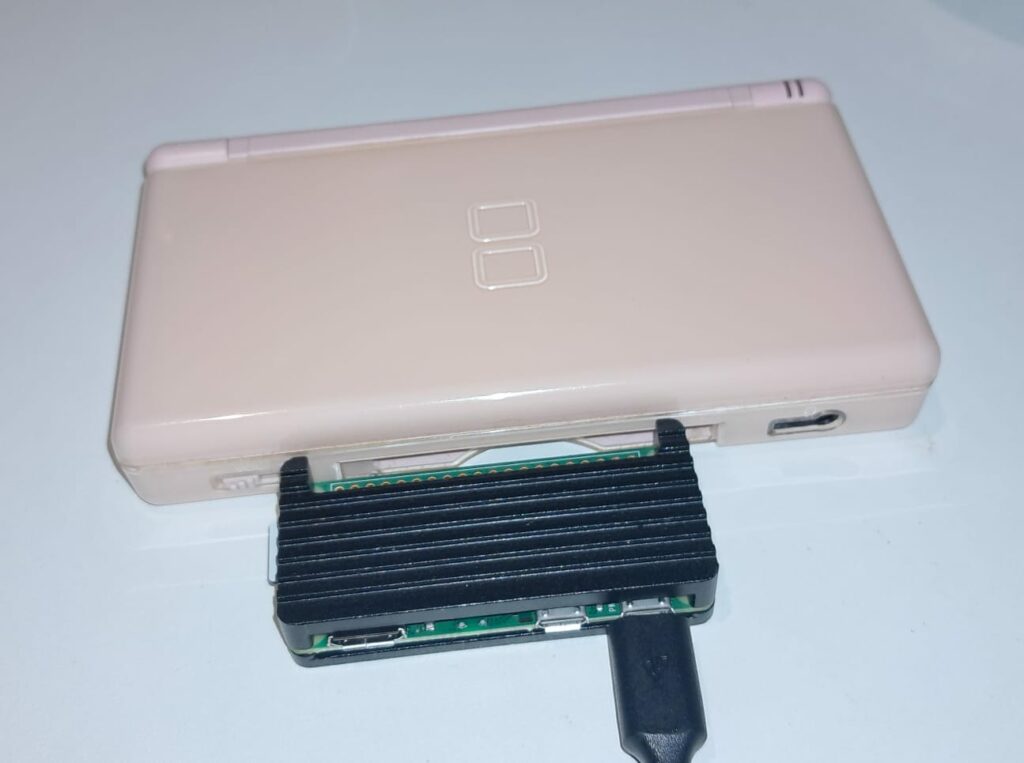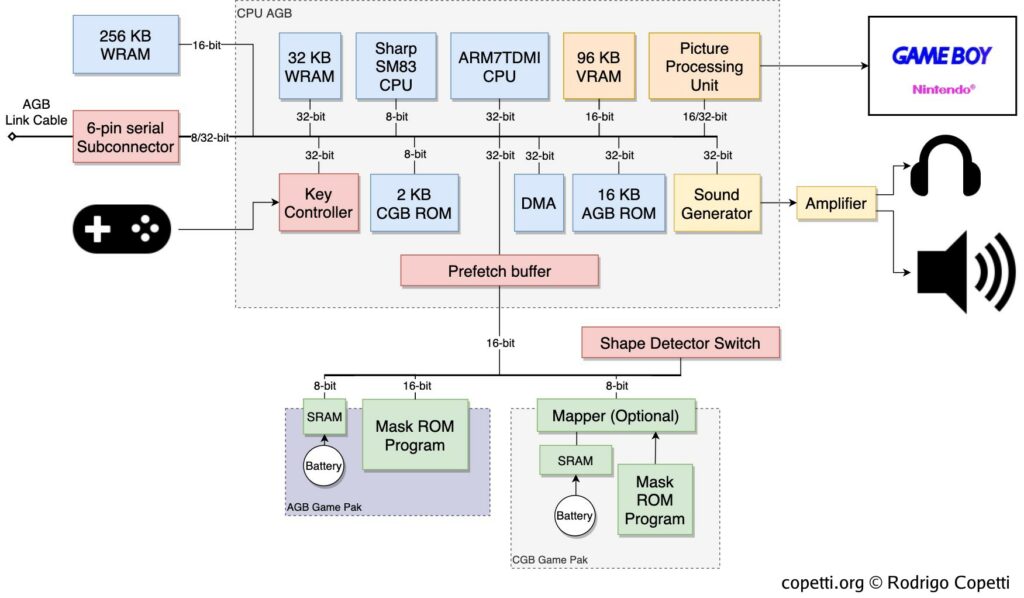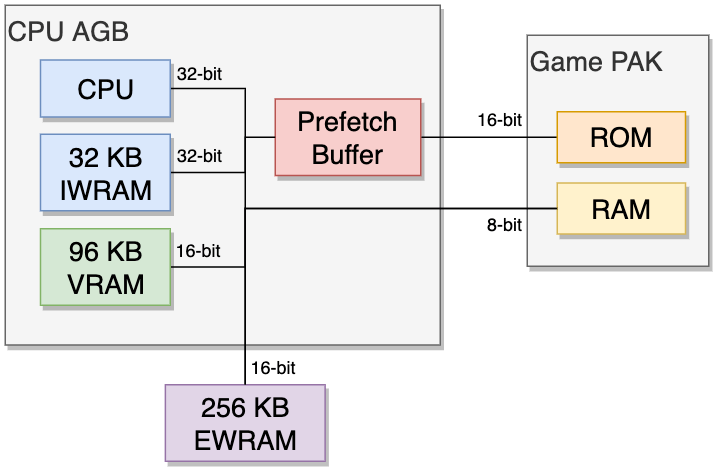Why?
I recently bought a Nintendo DS, and a Raspberry PI. Turns out the Nintendo DS can run Game Boy Advance (GBA) games, because they have the same CPU architecture.

Well, the Raspberry PI isn’t too far off too. Does it mean I can just run Gameboy Advance Games on the RPI too?
Well, that’s what this series will go to show. This week is about understanding feasibility and what I will be using (and why). The later weeks should explore things in a bit more technical detail.
Can it GameBoy Advance?
Let’s see what we need, to run it on the Raspberry Pi Zero 2 W. I’ve chosen it because its very small, but runs the same chip as the RPi 1.
This beautiful article “Game Boy Advance Architecture” by Rodrigo Copetti explains what’s required for a GBA, but, let’s break it down and compare it to the RPI Zero 2 W.
Also, let’s think about the weird stuff like Display, Audio and Input later. Being able to run stuff is more important.

So, let’s go by this order:
- CPU
- Memory
- I/O
CPU
The Zero 2 W has CPU with 4 Cortex A53 cores, whereas the GBA used a ARM7TDMI chip. The A53 might be ancient, but the ARM7TDMI is comparatively prehistoric.
But, delving into the A53 Technical Reference Manual, it is entirely backwards compatible with the ARM7TDMI! The AArch32 instruction set, seems to be a renamed edition of what the older GBA CPU used to use.
Awesome, so the RPI CPU can natively run all these instructions, no problems.
Memory

Oof, it gets complicated here. There’s few things:
- The AGB RAMs – They’re basically two different RAM chips, one smaller (32KB) and faster chip, and one larger (96KB) and slower chip.
- The even slower (but massive) EWRAM
- GamePAK memory – the Game Data
All of these items are laid out in the memory address space for the GBA CPU to access.
The GBA CPU accesses data through 32-bit addresses, and there’s a full address-layout map for fetching and storing data into these addresses.
Here’s the memory map from the no$gba documentation. (Ignore the Display Memory and I/O registers for now)

Intuitively, what this means is when the CPU tries to load data from 0x2000000, it loads the first byte of data from On-board WRAM. If it tries to use 0x3000000, it takes the first byte of data from the On-Chip Work RAM.
The RPI, unfortunately, has none of these mappings. It does however, has 512MB of RAM, which completely runs circles around what the GBA has for memory. Perhaps if there’s a way to create or simulate these mappings for the CPU to use?
I/O
We ignored the Display and IO memory mapping then, so we can discuss about it now. The display and the I/O is all memory-mapped. This means the data is directly available and usable via the memory.
The RPI, again, has none of this I/O. But it does have a lot of GPIO pins and display capabilities already, perhaps it can be “massaged” into the right shape and plugged into the GBA memory layout?
The initial hypothesis – Virtualization
Well, we had three finding:
- The GBA and RPI can both execute ARM code
- They differ in IO.
- They differ in memory mapping.
Well, in these cases, people usually use virtualization. Hmm… That seems awfully inefficient. I might as well use an existing emulator then, where it’ll also replicate the behaviour of the CPU. Although…
Hardware-Assisted Virtualization
Hardware assisted virtualization is a featureset of newer CPUs, where the CPUs can run guest code directly, skipping the need to emulate CPUs in software. Intel provides HAXM, AMD provides AMD-V, and ARM provides… well, something similar, but not sure what the name is. Let’s see how to use it in practi-
Terror
Looking into how to use it. I found – Trapping and Emulation of Instructions and ARM Virtualization Overview.

No, I can’t understand any of that. Understandable.
Looking online how it works, I remembered/found this neat thing – KVM. Linux takes all these features, and abstracts these architectures into one API, the KVM API. This allows Linux Hosts to run Guest machines with Hardware Accelerated execution.
KVM allows setting memory spaces, setting device specifications and runs code on a virtualized CPU that runs on the machine using the Virtualization Extensions on the CPU. Anything devices need virtualization? KVM gives control back to you to implement it yourself.
What’s better, the RPI Zero 2 W supports KVM.
$ ls /dev/kvm
crw-rw---- 1 root kvm 10, 232 Dec 7 19:29 /dev/kvm
The Final Problem Statement
So, let’s distill all of this into two questions:
- Can the GBA be run as a virtual machine on the Raspberry PI Zero 2 W?
- Is there any benefit to virtualization, instead of complete emulation?
Thus, the project advpi is planned to run GBA code on the PI Zero 2 W, by using a virtual machine.
The IO will need to be adapted and emulated by the software as well.
Display, can be showed on a window on-screen, and the sound can be played on the pi as it has sound capabilities as well (given a speaker is attached to it).
Anything else, will be figured out as it comes. Let’s see how that goes.
What’s next week?
- Setting up a workspace on a RPI.
- Testing the KVM API to run some x86 code, as it is well-documented.